Abstract
Information obtained from studies of developmental and cellular processes in lower organisms is beginning to make significant contributions to the understanding of the pathogenesis of human birth defects, and it is now becoming possible to treat birth defects as inborn errors of development. Mutations in genes for transcription factors, receptors, cell adhesion molecules, intercellular junctions, molecules involved in signal transduction, growth factors, structural proteins, enzymes, and transporters have been identified in genetically caused human malformations and dysplasias. The identification of these mutations and the analysis of their developmental effects have been greatly facilitated by the existence of natural or engineered models in the mouse and even of related mutations in Drosophila, and in some instances a remarkable conservation of function in development has been observed, even between widely separated species.
Full text
PDF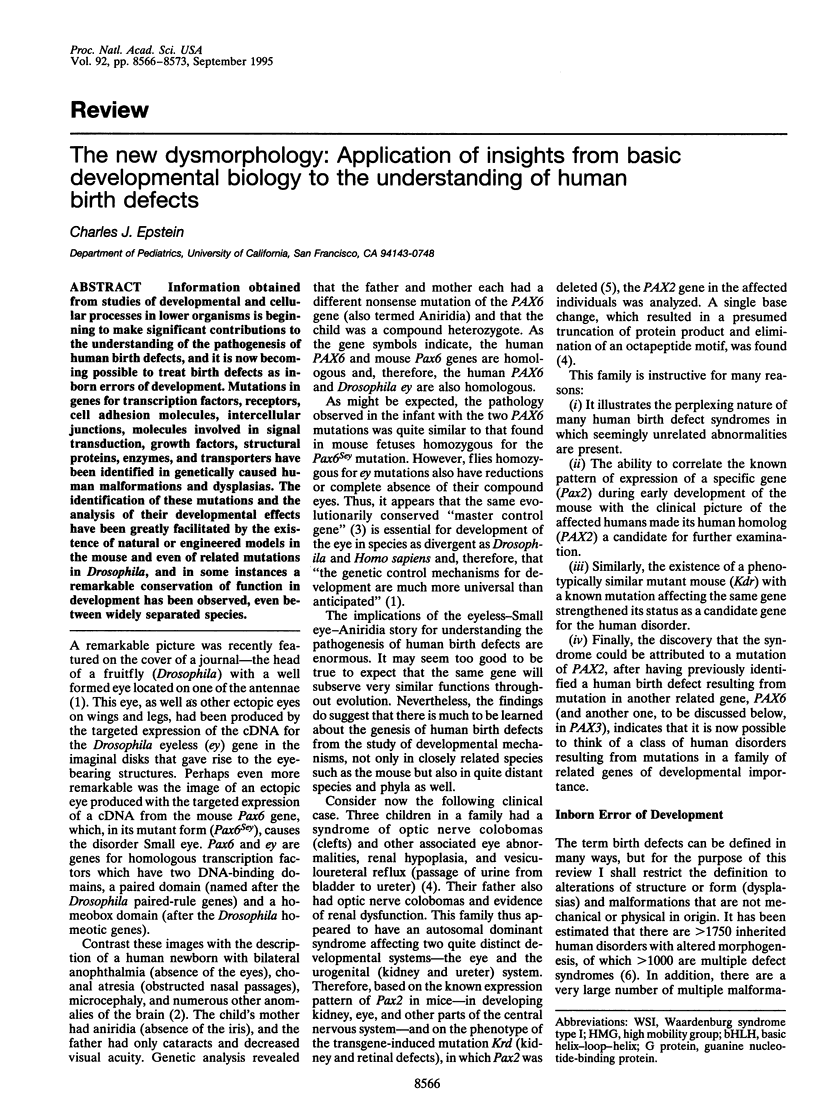
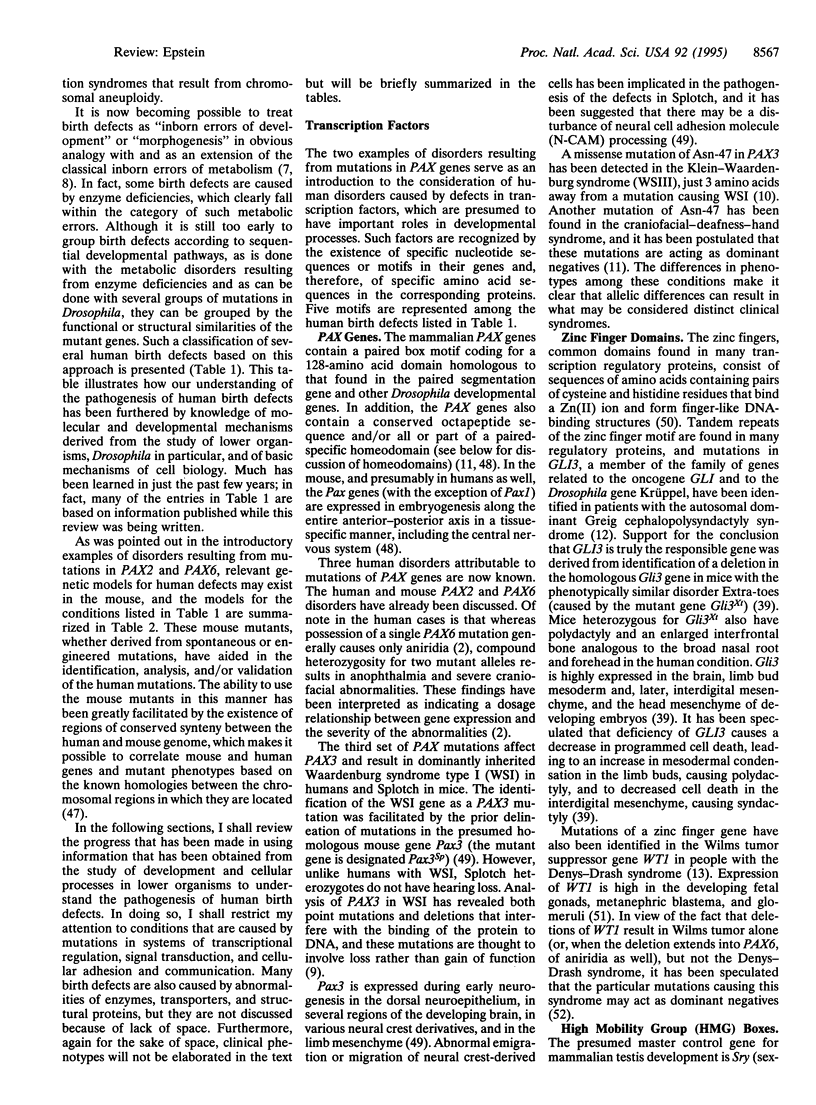
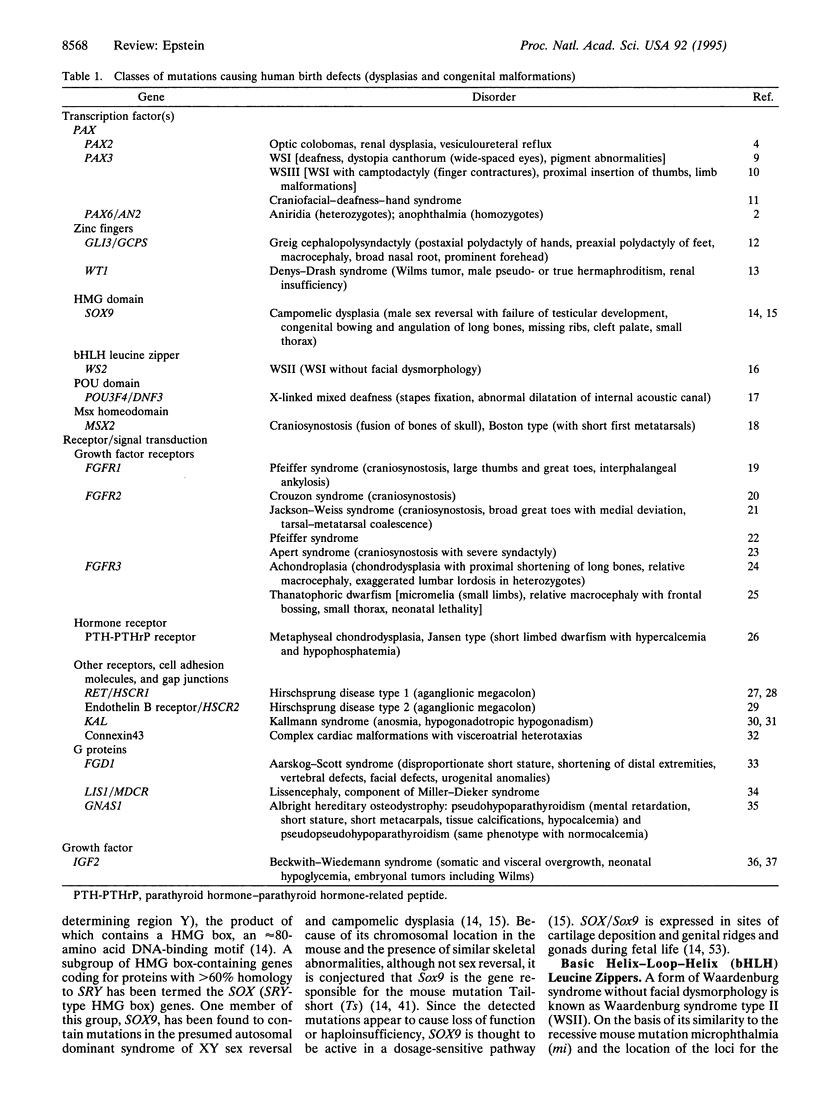
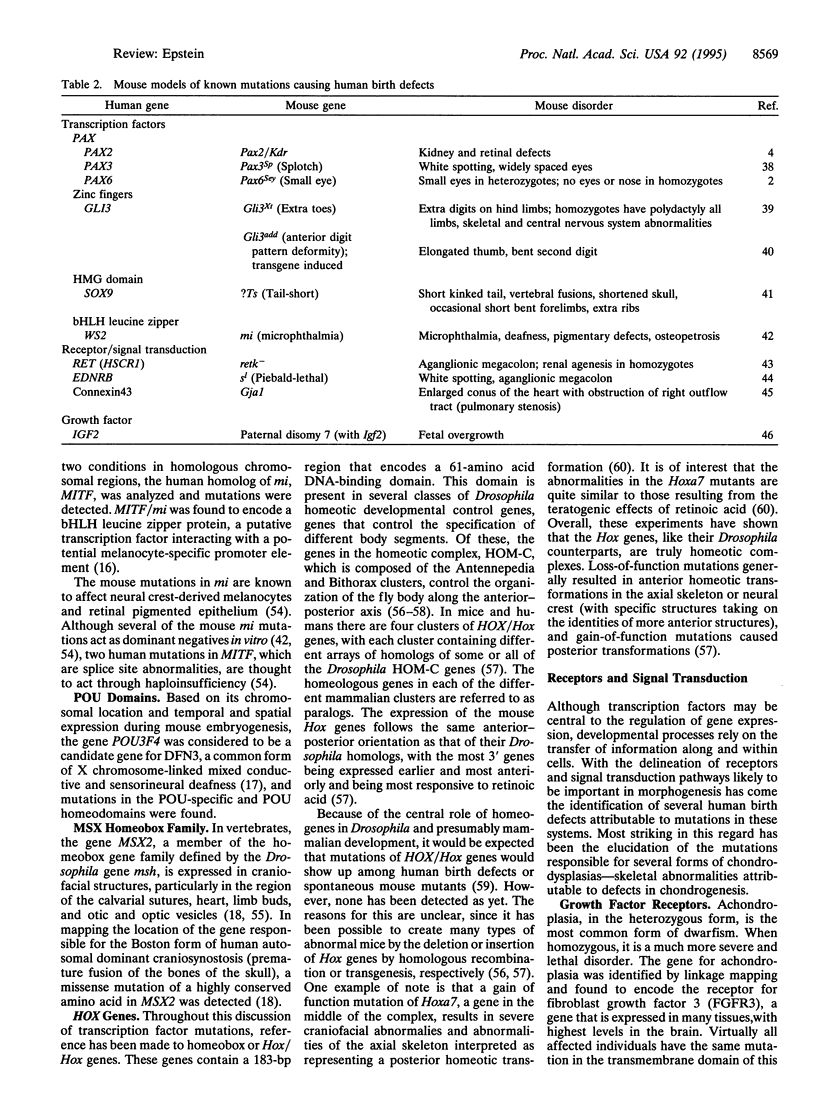
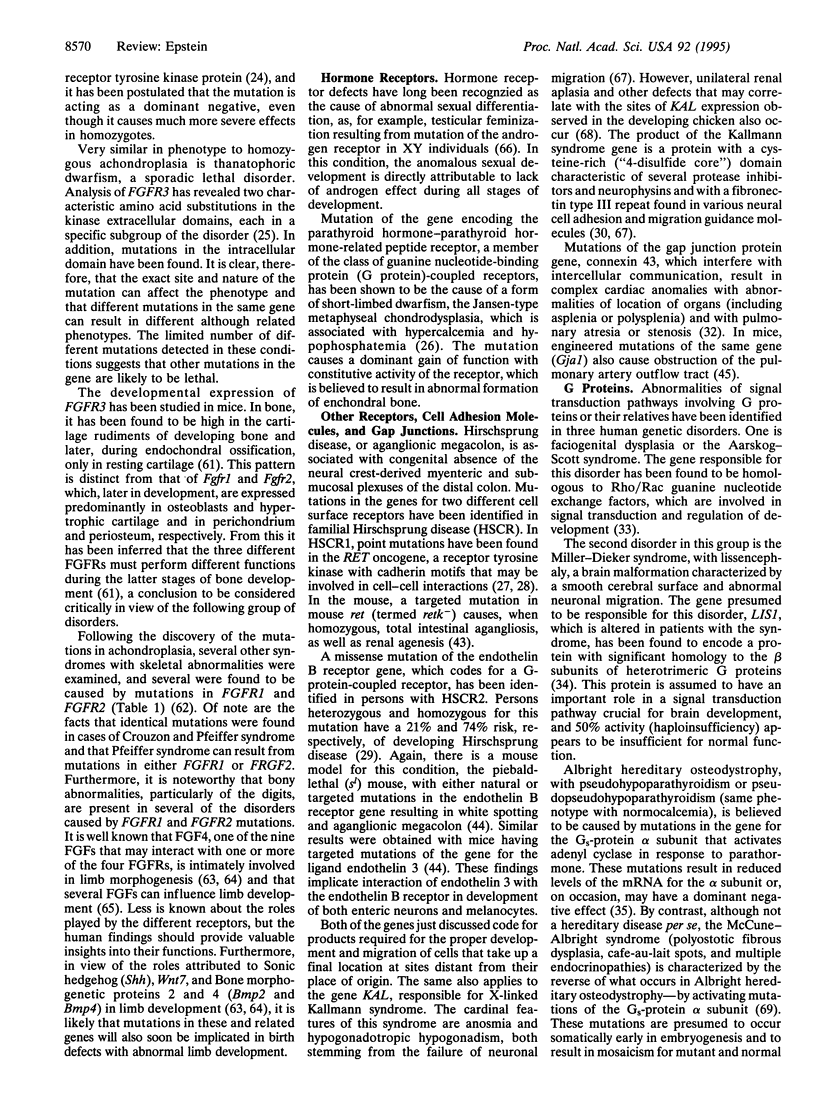
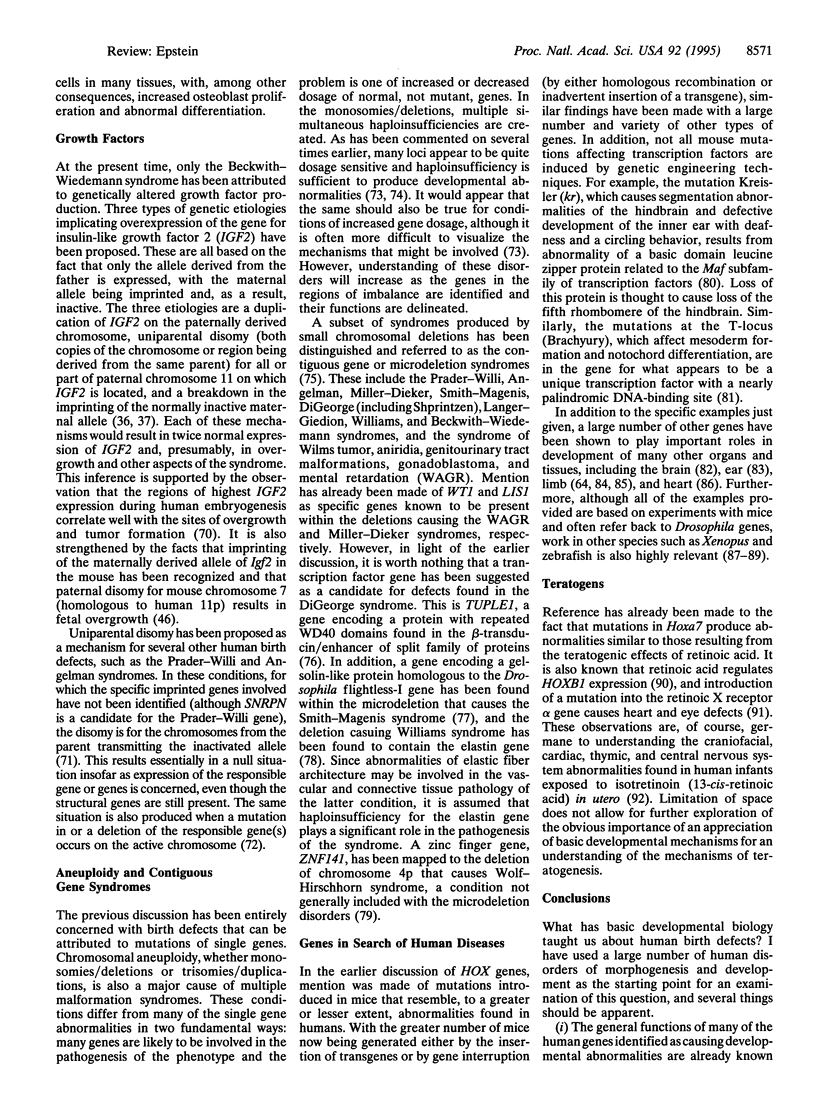
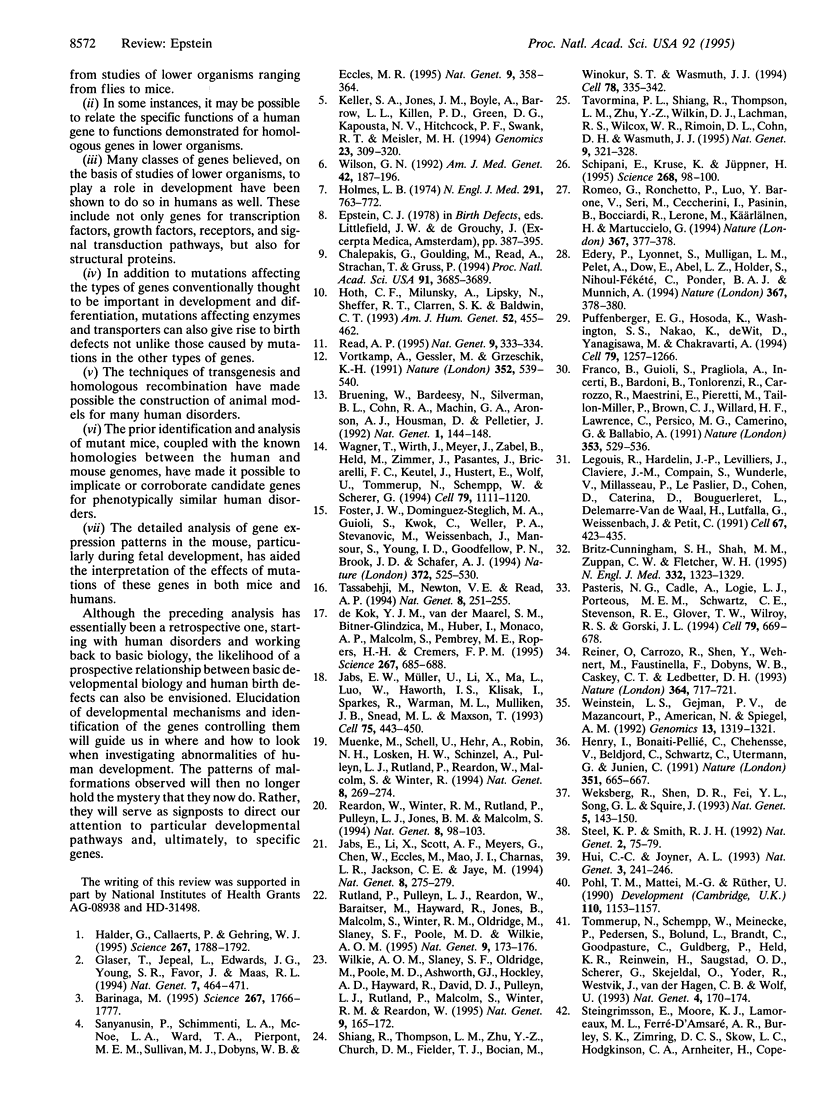
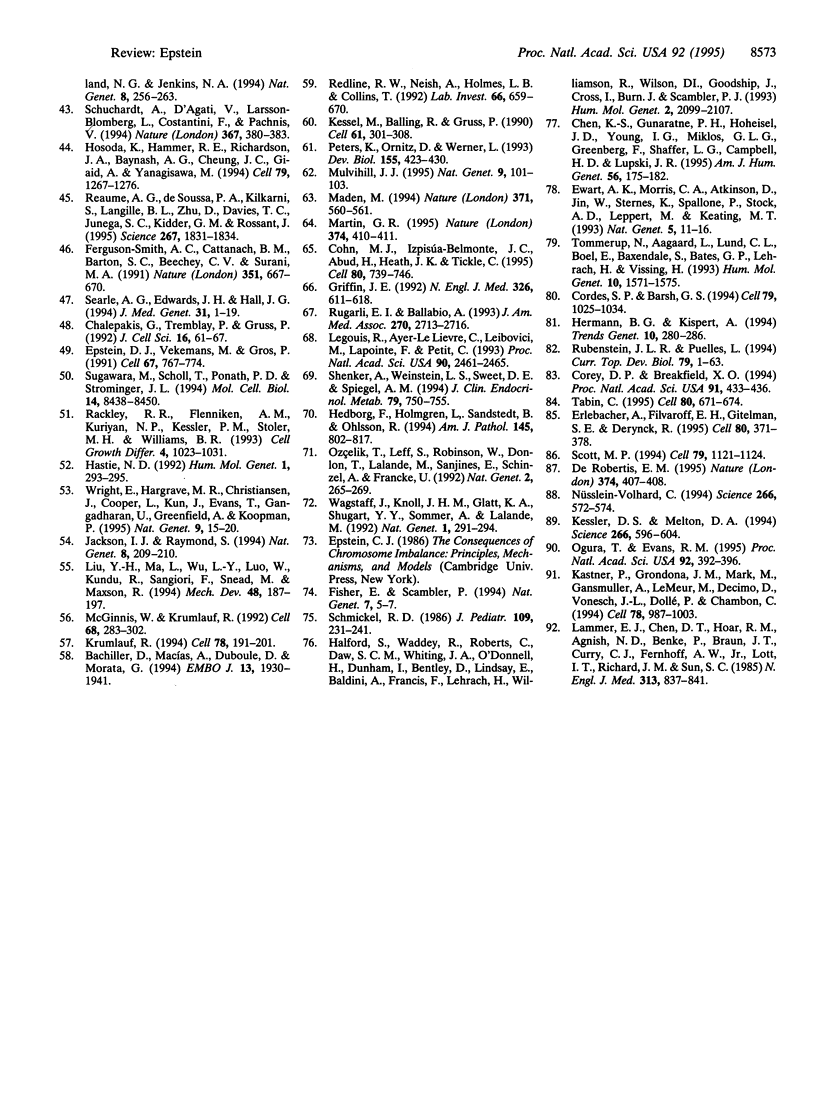
Selected References
These references are in PubMed. This may not be the complete list of references from this article.
- Bachiller D., Macías A., Duboule D., Morata G. Conservation of a functional hierarchy between mammalian and insect Hox/HOM genes. EMBO J. 1994 Apr 15;13(8):1930–1941. doi: 10.1002/j.1460-2075.1994.tb06462.x. [DOI] [PMC free article] [PubMed] [Google Scholar]
- Barinaga M. Focusing on the eyeless gene. Science. 1995 Mar 24;267(5205):1766–1767. doi: 10.1126/science.7892596. [DOI] [PubMed] [Google Scholar]
- Britz-Cunningham S. H., Shah M. M., Zuppan C. W., Fletcher W. H. Mutations of the Connexin43 gap-junction gene in patients with heart malformations and defects of laterality. N Engl J Med. 1995 May 18;332(20):1323–1329. doi: 10.1056/NEJM199505183322002. [DOI] [PubMed] [Google Scholar]
- Bruening W., Bardeesy N., Silverman B. L., Cohn R. A., Machin G. A., Aronson A. J., Housman D., Pelletier J. Germline intronic and exonic mutations in the Wilms' tumour gene (WT1) affecting urogenital development. Nat Genet. 1992 May;1(2):144–148. doi: 10.1038/ng0592-144. [DOI] [PubMed] [Google Scholar]
- Chalepakis G., Goulding M., Read A., Strachan T., Gruss P. Molecular basis of splotch and Waardenburg Pax-3 mutations. Proc Natl Acad Sci U S A. 1994 Apr 26;91(9):3685–3689. doi: 10.1073/pnas.91.9.3685. [DOI] [PMC free article] [PubMed] [Google Scholar]
- Chalepakis G., Tremblay P., Gruss P. Pax genes, mutants and molecular function. J Cell Sci Suppl. 1992;16:61–67. doi: 10.1242/jcs.1992.supplement_16.8. [DOI] [PubMed] [Google Scholar]
- Chen K. S., Gunaratne P. H., Hoheisel J. D., Young I. G., Miklos G. L., Greenberg F., Shaffer L. G., Campbell H. D., Lupski J. R. The human homologue of the Drosophila melanogaster flightless-I gene (flil) maps within the Smith-Magenis microdeletion critical region in 17p11.2. Am J Hum Genet. 1995 Jan;56(1):175–182. [PMC free article] [PubMed] [Google Scholar]
- Cohn M. J., Izpisúa-Belmonte J. C., Abud H., Heath J. K., Tickle C. Fibroblast growth factors induce additional limb development from the flank of chick embryos. Cell. 1995 Mar 10;80(5):739–746. doi: 10.1016/0092-8674(95)90352-6. [DOI] [PubMed] [Google Scholar]
- Cordes S. P., Barsh G. S. The mouse segmentation gene kr encodes a novel basic domain-leucine zipper transcription factor. Cell. 1994 Dec 16;79(6):1025–1034. doi: 10.1016/0092-8674(94)90033-7. [DOI] [PubMed] [Google Scholar]
- Corey D. P., Breakefield X. O. Transcription factors in inner ear development. Proc Natl Acad Sci U S A. 1994 Jan 18;91(2):433–436. doi: 10.1073/pnas.91.2.433. [DOI] [PMC free article] [PubMed] [Google Scholar]
- De Robertis E. M. Developmental biology. Dismantling the organizer. Nature. 1995 Mar 30;374(6521):407–408. doi: 10.1038/374407a0. [DOI] [PubMed] [Google Scholar]
- Edery P., Lyonnet S., Mulligan L. M., Pelet A., Dow E., Abel L., Holder S., Nihoul-Fékété C., Ponder B. A., Munnich A. Mutations of the RET proto-oncogene in Hirschsprung's disease. Nature. 1994 Jan 27;367(6461):378–380. doi: 10.1038/367378a0. [DOI] [PubMed] [Google Scholar]
- Epstein D. J., Vekemans M., Gros P. Splotch (Sp2H), a mutation affecting development of the mouse neural tube, shows a deletion within the paired homeodomain of Pax-3. Cell. 1991 Nov 15;67(4):767–774. doi: 10.1016/0092-8674(91)90071-6. [DOI] [PubMed] [Google Scholar]
- Erlebacher A., Filvaroff E. H., Gitelman S. E., Derynck R. Toward a molecular understanding of skeletal development. Cell. 1995 Feb 10;80(3):371–378. doi: 10.1016/0092-8674(95)90487-5. [DOI] [PubMed] [Google Scholar]
- Ewart A. K., Morris C. A., Atkinson D., Jin W., Sternes K., Spallone P., Stock A. D., Leppert M., Keating M. T. Hemizygosity at the elastin locus in a developmental disorder, Williams syndrome. Nat Genet. 1993 Sep;5(1):11–16. doi: 10.1038/ng0993-11. [DOI] [PubMed] [Google Scholar]
- Ferguson-Smith A. C., Cattanach B. M., Barton S. C., Beechey C. V., Surani M. A. Embryological and molecular investigations of parental imprinting on mouse chromosome 7. Nature. 1991 Jun 20;351(6328):667–670. doi: 10.1038/351667a0. [DOI] [PubMed] [Google Scholar]
- Fisher E., Scambler P. Human haploinsufficiency--one for sorrow, two for joy. Nat Genet. 1994 May;7(1):5–7. doi: 10.1038/ng0594-5. [DOI] [PubMed] [Google Scholar]
- Foster J. W., Dominguez-Steglich M. A., Guioli S., Kwok C., Weller P. A., Stevanović M., Weissenbach J., Mansour S., Young I. D., Goodfellow P. N. Campomelic dysplasia and autosomal sex reversal caused by mutations in an SRY-related gene. Nature. 1994 Dec 8;372(6506):525–530. doi: 10.1038/372525a0. [DOI] [PubMed] [Google Scholar]
- Franco B., Guioli S., Pragliola A., Incerti B., Bardoni B., Tonlorenzi R., Carrozzo R., Maestrini E., Pieretti M., Taillon-Miller P. A gene deleted in Kallmann's syndrome shares homology with neural cell adhesion and axonal path-finding molecules. Nature. 1991 Oct 10;353(6344):529–536. doi: 10.1038/353529a0. [DOI] [PubMed] [Google Scholar]
- Glaser T., Jepeal L., Edwards J. G., Young S. R., Favor J., Maas R. L. PAX6 gene dosage effect in a family with congenital cataracts, aniridia, anophthalmia and central nervous system defects. Nat Genet. 1994 Aug;7(4):463–471. doi: 10.1038/ng0894-463. [DOI] [PubMed] [Google Scholar]
- Griffin J. E. Androgen resistance--the clinical and molecular spectrum. N Engl J Med. 1992 Feb 27;326(9):611–618. doi: 10.1056/NEJM199202273260906. [DOI] [PubMed] [Google Scholar]
- Halder G., Callaerts P., Gehring W. J. Induction of ectopic eyes by targeted expression of the eyeless gene in Drosophila. Science. 1995 Mar 24;267(5205):1788–1792. doi: 10.1126/science.7892602. [DOI] [PubMed] [Google Scholar]
- Hastie N. D. Dominant negative mutations in the Wilms tumour (WT1) gene cause Denys-Drash syndrome--proof that a tumour-suppressor gene plays a crucial role in normal genitourinary development. Hum Mol Genet. 1992 Aug;1(5):293–295. doi: 10.1093/hmg/1.5.293. [DOI] [PubMed] [Google Scholar]
- Hedborg F., Holmgren L., Sandstedt B., Ohlsson R. The cell type-specific IGF2 expression during early human development correlates to the pattern of overgrowth and neoplasia in the Beckwith-Wiedemann syndrome. Am J Pathol. 1994 Oct;145(4):802–817. [PMC free article] [PubMed] [Google Scholar]
- Henry I., Bonaiti-Pellié C., Chehensse V., Beldjord C., Schwartz C., Utermann G., Junien C. Uniparental paternal disomy in a genetic cancer-predisposing syndrome. Nature. 1991 Jun 20;351(6328):665–667. doi: 10.1038/351665a0. [DOI] [PubMed] [Google Scholar]
- Herrmann B. G., Kispert A. The T genes in embryogenesis. Trends Genet. 1994 Aug;10(8):280–286. doi: 10.1016/0168-9525(90)90011-t. [DOI] [PubMed] [Google Scholar]
- Holmes L. B. Inborn errors of morphogenesis. A review of localized hereditary malformations. N Engl J Med. 1974 Oct 10;291(15):763–773. doi: 10.1056/NEJM197410102911505. [DOI] [PubMed] [Google Scholar]
- Hosoda K., Hammer R. E., Richardson J. A., Baynash A. G., Cheung J. C., Giaid A., Yanagisawa M. Targeted and natural (piebald-lethal) mutations of endothelin-B receptor gene produce megacolon associated with spotted coat color in mice. Cell. 1994 Dec 30;79(7):1267–1276. doi: 10.1016/0092-8674(94)90017-5. [DOI] [PubMed] [Google Scholar]
- Hoth C. F., Milunsky A., Lipsky N., Sheffer R., Clarren S. K., Baldwin C. T. Mutations in the paired domain of the human PAX3 gene cause Klein-Waardenburg syndrome (WS-III) as well as Waardenburg syndrome type I (WS-I). Am J Hum Genet. 1993 Mar;52(3):455–462. [PMC free article] [PubMed] [Google Scholar]
- Hui C. C., Joyner A. L. A mouse model of greig cephalopolysyndactyly syndrome: the extra-toesJ mutation contains an intragenic deletion of the Gli3 gene. Nat Genet. 1993 Mar;3(3):241–246. doi: 10.1038/ng0393-241. [DOI] [PubMed] [Google Scholar]
- Jabs E. W., Li X., Scott A. F., Meyers G., Chen W., Eccles M., Mao J. I., Charnas L. R., Jackson C. E., Jaye M. Jackson-Weiss and Crouzon syndromes are allelic with mutations in fibroblast growth factor receptor 2. Nat Genet. 1994 Nov;8(3):275–279. doi: 10.1038/ng1194-275. [DOI] [PubMed] [Google Scholar]
- Jabs E. W., Müller U., Li X., Ma L., Luo W., Haworth I. S., Klisak I., Sparkes R., Warman M. L., Mulliken J. B. A mutation in the homeodomain of the human MSX2 gene in a family affected with autosomal dominant craniosynostosis. Cell. 1993 Nov 5;75(3):443–450. doi: 10.1016/0092-8674(93)90379-5. [DOI] [PubMed] [Google Scholar]
- Jackson I. J., Raymond S. Manifestations of microphthalmia. Nat Genet. 1994 Nov;8(3):209–210. doi: 10.1038/ng1194-209. [DOI] [PubMed] [Google Scholar]
- Kastner P., Grondona J. M., Mark M., Gansmuller A., LeMeur M., Decimo D., Vonesch J. L., Dollé P., Chambon P. Genetic analysis of RXR alpha developmental function: convergence of RXR and RAR signaling pathways in heart and eye morphogenesis. Cell. 1994 Sep 23;78(6):987–1003. doi: 10.1016/0092-8674(94)90274-7. [DOI] [PubMed] [Google Scholar]
- Keller S. A., Jones J. M., Boyle A., Barrow L. L., Killen P. D., Green D. G., Kapousta N. V., Hitchcock P. F., Swank R. T., Meisler M. H. Kidney and retinal defects (Krd), a transgene-induced mutation with a deletion of mouse chromosome 19 that includes the Pax2 locus. Genomics. 1994 Sep 15;23(2):309–320. doi: 10.1006/geno.1994.1506. [DOI] [PubMed] [Google Scholar]
- Kessel M., Balling R., Gruss P. Variations of cervical vertebrae after expression of a Hox-1.1 transgene in mice. Cell. 1990 Apr 20;61(2):301–308. doi: 10.1016/0092-8674(90)90810-2. [DOI] [PubMed] [Google Scholar]
- Kessler D. S., Melton D. A. Vertebrate embryonic induction: mesodermal and neural patterning. Science. 1994 Oct 28;266(5185):596–604. doi: 10.1126/science.7939714. [DOI] [PubMed] [Google Scholar]
- Krumlauf R. Hox genes in vertebrate development. Cell. 1994 Jul 29;78(2):191–201. doi: 10.1016/0092-8674(94)90290-9. [DOI] [PubMed] [Google Scholar]
- Lammer E. J., Chen D. T., Hoar R. M., Agnish N. D., Benke P. J., Braun J. T., Curry C. J., Fernhoff P. M., Grix A. W., Jr, Lott I. T. Retinoic acid embryopathy. N Engl J Med. 1985 Oct 3;313(14):837–841. doi: 10.1056/NEJM198510033131401. [DOI] [PubMed] [Google Scholar]
- Legouis R., Hardelin J. P., Levilliers J., Claverie J. M., Compain S., Wunderle V., Millasseau P., Le Paslier D., Cohen D., Caterina D. The candidate gene for the X-linked Kallmann syndrome encodes a protein related to adhesion molecules. Cell. 1991 Oct 18;67(2):423–435. doi: 10.1016/0092-8674(91)90193-3. [DOI] [PubMed] [Google Scholar]
- Legouis R., Lievre C. A., Leibovici M., Lapointe F., Petit C. Expression of the KAL gene in multiple neuronal sites during chicken development. Proc Natl Acad Sci U S A. 1993 Mar 15;90(6):2461–2465. doi: 10.1073/pnas.90.6.2461. [DOI] [PMC free article] [PubMed] [Google Scholar]
- Liu Y. H., Ma L., Wu L. Y., Luo W., Kundu R., Sangiorgi F., Snead M. L., Maxson R. Regulation of the Msx2 homeobox gene during mouse embryogenesis: a transgene with 439 bp of 5' flanking sequence is expressed exclusively in the apical ectodermal ridge of the developing limb. Mech Dev. 1994 Dec;48(3):187–197. doi: 10.1016/0925-4773(94)90059-0. [DOI] [PubMed] [Google Scholar]
- Maden M. Developmental biology. The limb bud--Part two. Nature. 1994 Oct 13;371(6498):560–561. doi: 10.1038/371560a0. [DOI] [PubMed] [Google Scholar]
- Martin G. R. Developmental biology. Why thumbs are up. Nature. 1995 Mar 30;374(6521):410–411. doi: 10.1038/374410a0. [DOI] [PubMed] [Google Scholar]
- McGinnis W., Krumlauf R. Homeobox genes and axial patterning. Cell. 1992 Jan 24;68(2):283–302. doi: 10.1016/0092-8674(92)90471-n. [DOI] [PubMed] [Google Scholar]
- Muenke M., Schell U., Hehr A., Robin N. H., Losken H. W., Schinzel A., Pulleyn L. J., Rutland P., Reardon W., Malcolm S. A common mutation in the fibroblast growth factor receptor 1 gene in Pfeiffer syndrome. Nat Genet. 1994 Nov;8(3):269–274. doi: 10.1038/ng1194-269. [DOI] [PubMed] [Google Scholar]
- Mulvihill J. J. Craniofacial syndromes: no such thing as a single gene disease. Nat Genet. 1995 Feb;9(2):101–103. doi: 10.1038/ng0295-101. [DOI] [PubMed] [Google Scholar]
- Nüsslein-Volhard C. Of flies and fishes. Science. 1994 Oct 28;266(5185):572–574. doi: 10.1126/science.7939708. [DOI] [PubMed] [Google Scholar]
- Ogura T., Evans R. M. Evidence for two distinct retinoic acid response pathways for HOXB1 gene regulation. Proc Natl Acad Sci U S A. 1995 Jan 17;92(2):392–396. doi: 10.1073/pnas.92.2.392. [DOI] [PMC free article] [PubMed] [Google Scholar]
- Ozçelik T., Leff S., Robinson W., Donlon T., Lalande M., Sanjines E., Schinzel A., Francke U. Small nuclear ribonucleoprotein polypeptide N (SNRPN), an expressed gene in the Prader-Willi syndrome critical region. Nat Genet. 1992 Dec;2(4):265–269. doi: 10.1038/ng1292-265. [DOI] [PubMed] [Google Scholar]
- Pasteris N. G., Cadle A., Logie L. J., Porteous M. E., Schwartz C. E., Stevenson R. E., Glover T. W., Wilroy R. S., Gorski J. L. Isolation and characterization of the faciogenital dysplasia (Aarskog-Scott syndrome) gene: a putative Rho/Rac guanine nucleotide exchange factor. Cell. 1994 Nov 18;79(4):669–678. doi: 10.1016/0092-8674(94)90552-5. [DOI] [PubMed] [Google Scholar]
- Peters K., Ornitz D., Werner S., Williams L. Unique expression pattern of the FGF receptor 3 gene during mouse organogenesis. Dev Biol. 1993 Feb;155(2):423–430. doi: 10.1006/dbio.1993.1040. [DOI] [PubMed] [Google Scholar]
- Pohl T. M., Mattei M. G., Rüther U. Evidence for allelism of the recessive insertional mutation add and the dominant mouse mutation extra-toes (Xt). Development. 1990 Dec;110(4):1153–1157. doi: 10.1242/dev.110.4.1153. [DOI] [PubMed] [Google Scholar]
- Puffenberger E. G., Hosoda K., Washington S. S., Nakao K., deWit D., Yanagisawa M., Chakravart A. A missense mutation of the endothelin-B receptor gene in multigenic Hirschsprung's disease. Cell. 1994 Dec 30;79(7):1257–1266. doi: 10.1016/0092-8674(94)90016-7. [DOI] [PubMed] [Google Scholar]
- Rackley R. R., Flenniken A. M., Kuriyan N. P., Kessler P. M., Stoler M. H., Williams B. R. Expression of the Wilms' tumor suppressor gene WT1 during mouse embryogenesis. Cell Growth Differ. 1993 Dec;4(12):1023–1031. [PubMed] [Google Scholar]
- Read A. P. Pax genes--paired feet in three camps. Nat Genet. 1995 Apr;9(4):333–334. doi: 10.1038/ng0495-333. [DOI] [PubMed] [Google Scholar]
- Reardon W., Winter R. M., Rutland P., Pulleyn L. J., Jones B. M., Malcolm S. Mutations in the fibroblast growth factor receptor 2 gene cause Crouzon syndrome. Nat Genet. 1994 Sep;8(1):98–103. doi: 10.1038/ng0994-98. [DOI] [PubMed] [Google Scholar]
- Reaume A. G., de Sousa P. A., Kulkarni S., Langille B. L., Zhu D., Davies T. C., Juneja S. C., Kidder G. M., Rossant J. Cardiac malformation in neonatal mice lacking connexin43. Science. 1995 Mar 24;267(5205):1831–1834. doi: 10.1126/science.7892609. [DOI] [PubMed] [Google Scholar]
- Redline R. W., Neish A., Holmes L. B., Collins T. Homeobox genes and congenital malformations. Lab Invest. 1992 Jun;66(6):659–670. [PubMed] [Google Scholar]
- Reiner O., Carrozzo R., Shen Y., Wehnert M., Faustinella F., Dobyns W. B., Caskey C. T., Ledbetter D. H. Isolation of a Miller-Dieker lissencephaly gene containing G protein beta-subunit-like repeats. Nature. 1993 Aug 19;364(6439):717–721. doi: 10.1038/364717a0. [DOI] [PubMed] [Google Scholar]
- Romeo G., Ronchetto P., Luo Y., Barone V., Seri M., Ceccherini I., Pasini B., Bocciardi R., Lerone M., Käriäinen H. Point mutations affecting the tyrosine kinase domain of the RET proto-oncogene in Hirschsprung's disease. Nature. 1994 Jan 27;367(6461):377–378. doi: 10.1038/367377a0. [DOI] [PubMed] [Google Scholar]
- Rubenstein J. L., Puelles L. Homeobox gene expression during development of the vertebrate brain. Curr Top Dev Biol. 1994;29:1–63. doi: 10.1016/s0070-2153(08)60546-3. [DOI] [PubMed] [Google Scholar]
- Rugarli E. I., Ballabio A. Kallmann syndrome. From genetics to neurobiology. JAMA. 1993 Dec 8;270(22):2713–2716. doi: 10.1001/jama.270.22.2713. [DOI] [PubMed] [Google Scholar]
- Rutland P., Pulleyn L. J., Reardon W., Baraitser M., Hayward R., Jones B., Malcolm S., Winter R. M., Oldridge M., Slaney S. F. Identical mutations in the FGFR2 gene cause both Pfeiffer and Crouzon syndrome phenotypes. Nat Genet. 1995 Feb;9(2):173–176. doi: 10.1038/ng0295-173. [DOI] [PubMed] [Google Scholar]
- Sanyanusin P., Schimmenti L. A., McNoe L. A., Ward T. A., Pierpont M. E., Sullivan M. J., Dobyns W. B., Eccles M. R. Mutation of the PAX2 gene in a family with optic nerve colobomas, renal anomalies and vesicoureteral reflux. Nat Genet. 1995 Apr;9(4):358–364. doi: 10.1038/ng0495-358. [DOI] [PubMed] [Google Scholar]
- Schipani E., Kruse K., Jüppner H. A constitutively active mutant PTH-PTHrP receptor in Jansen-type metaphyseal chondrodysplasia. Science. 1995 Apr 7;268(5207):98–100. doi: 10.1126/science.7701349. [DOI] [PubMed] [Google Scholar]
- Schmickel R. D. Contiguous gene syndromes: a component of recognizable syndromes. J Pediatr. 1986 Aug;109(2):231–241. doi: 10.1016/s0022-3476(86)80377-8. [DOI] [PubMed] [Google Scholar]
- Schuchardt A., D'Agati V., Larsson-Blomberg L., Costantini F., Pachnis V. Defects in the kidney and enteric nervous system of mice lacking the tyrosine kinase receptor Ret. Nature. 1994 Jan 27;367(6461):380–383. doi: 10.1038/367380a0. [DOI] [PubMed] [Google Scholar]
- Scott M. P. Intimations of a creature. Cell. 1994 Dec 30;79(7):1121–1124. doi: 10.1016/0092-8674(94)90001-9. [DOI] [PubMed] [Google Scholar]
- Searle A. G., Edwards J. H., Hall J. G. Mouse homologues of human hereditary disease. J Med Genet. 1994 Jan;31(1):1–19. doi: 10.1136/jmg.31.1.1. [DOI] [PMC free article] [PubMed] [Google Scholar]
- Shenker A., Weinstein L. S., Sweet D. E., Spiegel A. M. An activating Gs alpha mutation is present in fibrous dysplasia of bone in the McCune-Albright syndrome. J Clin Endocrinol Metab. 1994 Sep;79(3):750–755. doi: 10.1210/jcem.79.3.8077356. [DOI] [PubMed] [Google Scholar]
- Shiang R., Thompson L. M., Zhu Y. Z., Church D. M., Fielder T. J., Bocian M., Winokur S. T., Wasmuth J. J. Mutations in the transmembrane domain of FGFR3 cause the most common genetic form of dwarfism, achondroplasia. Cell. 1994 Jul 29;78(2):335–342. doi: 10.1016/0092-8674(94)90302-6. [DOI] [PubMed] [Google Scholar]
- Steel K. P., Smith R. J. Normal hearing in Splotch (Sp/+), the mouse homologue of Waardenburg syndrome type 1. Nat Genet. 1992 Sep;2(1):75–79. doi: 10.1038/ng0992-75. [DOI] [PubMed] [Google Scholar]
- Sugawara M., Scholl T., Ponath P. D., Strominger J. L. A factor that regulates the class II major histocompatibility complex gene DPA is a member of a subfamily of zinc finger proteins that includes a Drosophila developmental control protein. Mol Cell Biol. 1994 Dec;14(12):8438–8450. doi: 10.1128/mcb.14.12.8438. [DOI] [PMC free article] [PubMed] [Google Scholar]
- Tabin C. The initiation of the limb bud: growth factors, Hox genes, and retinoids. Cell. 1995 Mar 10;80(5):671–674. doi: 10.1016/0092-8674(95)90343-7. [DOI] [PubMed] [Google Scholar]
- Tassabehji M., Newton V. E., Read A. P. Waardenburg syndrome type 2 caused by mutations in the human microphthalmia (MITF) gene. Nat Genet. 1994 Nov;8(3):251–255. doi: 10.1038/ng1194-251. [DOI] [PubMed] [Google Scholar]
- Tavormina P. L., Shiang R., Thompson L. M., Zhu Y. Z., Wilkin D. J., Lachman R. S., Wilcox W. R., Rimoin D. L., Cohn D. H., Wasmuth J. J. Thanatophoric dysplasia (types I and II) caused by distinct mutations in fibroblast growth factor receptor 3. Nat Genet. 1995 Mar;9(3):321–328. doi: 10.1038/ng0395-321. [DOI] [PubMed] [Google Scholar]
- Tommerup N., Aagaard L., Lund C. L., Boel E., Baxendale S., Bates G. P., Lehrach H., Vissing H. A zinc-finger gene ZNF141 mapping at 4p16.3/D4S90 is a candidate gene for the Wolf-Hirschhorn (4p-) syndrome. Hum Mol Genet. 1993 Oct;2(10):1571–1575. doi: 10.1093/hmg/2.10.1571. [DOI] [PubMed] [Google Scholar]
- Tommerup N., Schempp W., Meinecke P., Pedersen S., Bolund L., Brandt C., Goodpasture C., Guldberg P., Held K. R., Reinwein H. Assignment of an autosomal sex reversal locus (SRA1) and campomelic dysplasia (CMPD1) to 17q24.3-q25.1. Nat Genet. 1993 Jun;4(2):170–174. doi: 10.1038/ng0693-170. [DOI] [PubMed] [Google Scholar]
- Vortkamp A., Gessler M., Grzeschik K. H. GLI3 zinc-finger gene interrupted by translocations in Greig syndrome families. Nature. 1991 Aug 8;352(6335):539–540. doi: 10.1038/352539a0. [DOI] [PubMed] [Google Scholar]
- Wagner T., Wirth J., Meyer J., Zabel B., Held M., Zimmer J., Pasantes J., Bricarelli F. D., Keutel J., Hustert E. Autosomal sex reversal and campomelic dysplasia are caused by mutations in and around the SRY-related gene SOX9. Cell. 1994 Dec 16;79(6):1111–1120. doi: 10.1016/0092-8674(94)90041-8. [DOI] [PubMed] [Google Scholar]
- Wagstaff J., Knoll J. H., Glatt K. A., Shugart Y. Y., Sommer A., Lalande M. Maternal but not paternal transmission of 15q11-13-linked nondeletion Angelman syndrome leads to phenotypic expression. Nat Genet. 1992 Jul;1(4):291–294. doi: 10.1038/ng0792-291. [DOI] [PubMed] [Google Scholar]
- Weinstein L. S., Gejman P. V., de Mazancourt P., American N., Spiegel A. M. A heterozygous 4-bp deletion mutation in the Gs alpha gene (GNAS1) in a patient with Albright hereditary osteodystrophy. Genomics. 1992 Aug;13(4):1319–1321. doi: 10.1016/0888-7543(92)90056-x. [DOI] [PubMed] [Google Scholar]
- Weksberg R., Shen D. R., Fei Y. L., Song Q. L., Squire J. Disruption of insulin-like growth factor 2 imprinting in Beckwith-Wiedemann syndrome. Nat Genet. 1993 Oct;5(2):143–150. doi: 10.1038/ng1093-143. [DOI] [PubMed] [Google Scholar]
- Wilkie A. O., Slaney S. F., Oldridge M., Poole M. D., Ashworth G. J., Hockley A. D., Hayward R. D., David D. J., Pulleyn L. J., Rutland P. Apert syndrome results from localized mutations of FGFR2 and is allelic with Crouzon syndrome. Nat Genet. 1995 Feb;9(2):165–172. doi: 10.1038/ng0295-165. [DOI] [PubMed] [Google Scholar]
- Wilson G. N. Genomics of human dysmorphogenesis. Am J Med Genet. 1992 Jan 15;42(2):187–196. doi: 10.1002/ajmg.1320420211. [DOI] [PubMed] [Google Scholar]
- Wright E., Hargrave M. R., Christiansen J., Cooper L., Kun J., Evans T., Gangadharan U., Greenfield A., Koopman P. The Sry-related gene Sox9 is expressed during chondrogenesis in mouse embryos. Nat Genet. 1995 Jan;9(1):15–20. doi: 10.1038/ng0195-15. [DOI] [PubMed] [Google Scholar]
- de Kok Y. J., van der Maarel S. M., Bitner-Glindzicz M., Huber I., Monaco A. P., Malcolm S., Pembrey M. E., Ropers H. H., Cremers F. P. Association between X-linked mixed deafness and mutations in the POU domain gene POU3F4. Science. 1995 Feb 3;267(5198):685–688. doi: 10.1126/science.7839145. [DOI] [PubMed] [Google Scholar]


